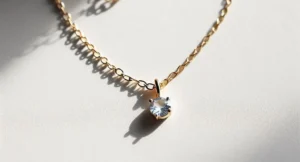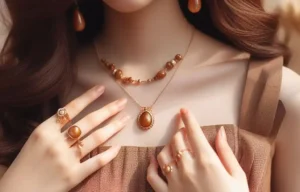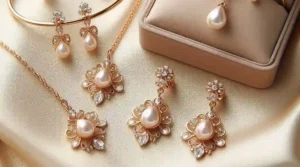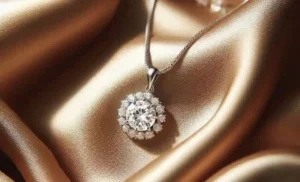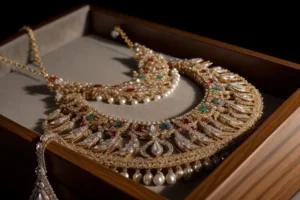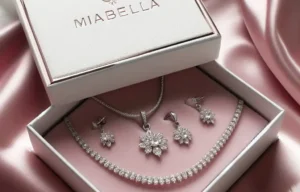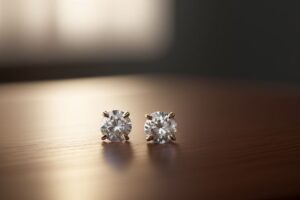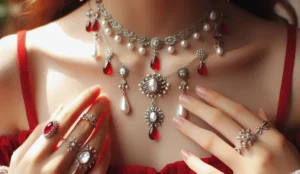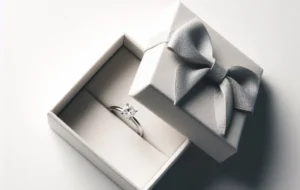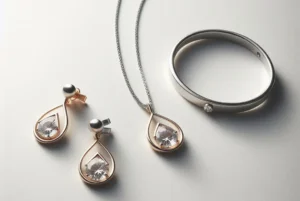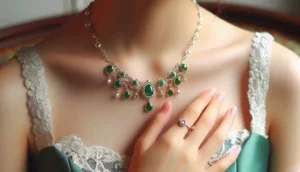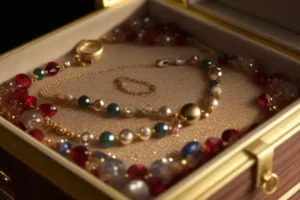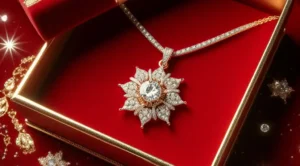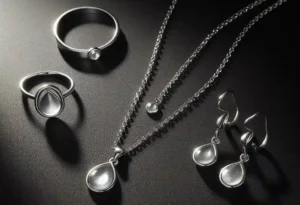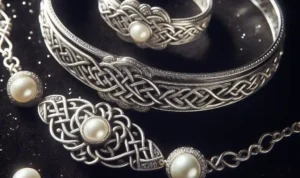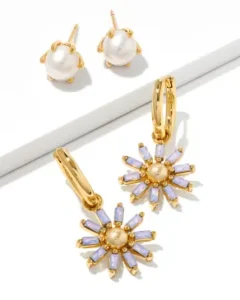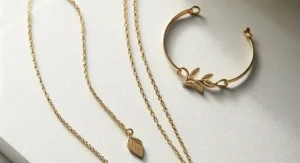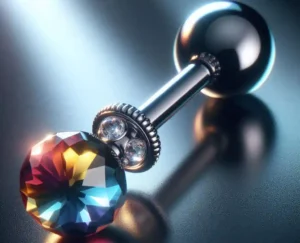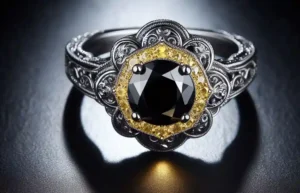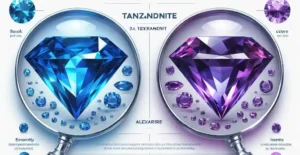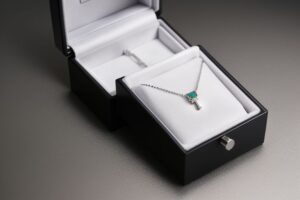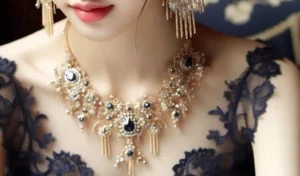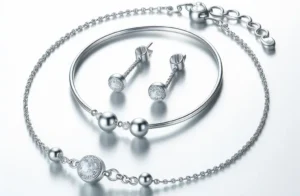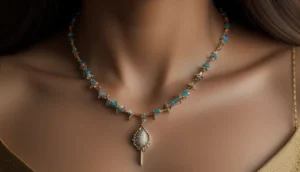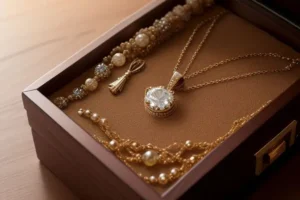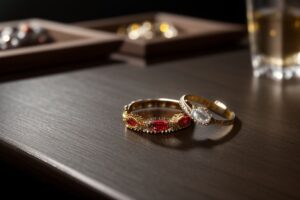Does Rhodium Turn Skin Green? In the world of jewelry, the quest for stunning and durable pieces can often lead consumers down a path of curiosity and caution, especially when it comes to the effects such adornments might have on their skin.
Among the various metals used in jewelry, rhodium stands out for its lustrous finish and robustness.
Let’s delve into this topic to unveil the truth behind rhodium jewelry and its impact on skin.
Does Rhodium Turn Skin Green?
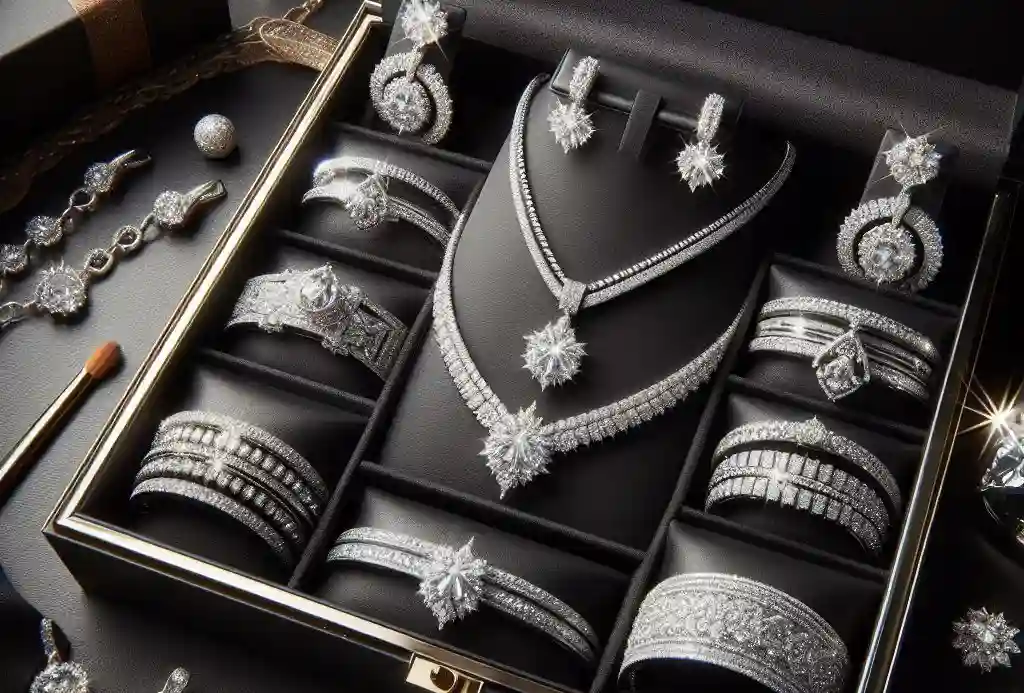
No, rhodium itself does not turn skin green. This metal is known for its inert qualities, meaning it does not react with the skin or the environment in ways that lead to discoloration.
Unlike other metals that may contain elements like copper, which reacts to form green salts on the skin, rhodium remains stable. It is often used as a plating over other metals to enhance luster and prevent tarnishing.
This protective layer also shields the skin from potential reactions with base metals that might be prone to causing discoloration.
Therefore, any green discoloration experienced while wearing rhodium-plated jewelry is likely due to the exposure of underlying metals, not the rhodium itself.
Understanding Rhodium and Its Use in Jewelry
Rhodium, a rare and precious metal from the platinum group, is highly valued in the jewelry industry for its extraordinary shine and its ability to resist tarnishing. Its primary application in jewelry-making involves a plating process where a thin layer of rhodium is applied over other metals, such as silver or white gold.
This process not only enhances the luster and reflectiveness of the jewelry but also adds a protective barrier. This barrier shields the base metal from scratches, wear, and exposure to corrosive substances, effectively prolonging the jewelry’s life.
Rhodium plating is especially popular for items like rings and bracelets, which are subject to frequent contact and can quickly lose their initial appeal without this added layer of protection.
The application of rhodium plating is a sophisticated process that requires both precision and skill, contributing to the higher cost of rhodium-plated jewelry compared to pieces plated with less rare metals. Despite its cost, the demand for rhodium-plated jewelry remains high, thanks to its numerous benefits.
These include not only an enhanced aesthetic appeal but also increased longevity and maintenance of the piece’s original appearance over time.
When selecting rhodium-plated jewelry, it is essential to consider the quality of both the plating process and the underlying metal, as these factors significantly influence the durability and appearance of the final product.
Rhodium’s remarkable characteristics make it a preferred choice for jewelry that combines the timeless beauty of precious metals with the practicality needed for everyday wear.
The Science Behind Jewelry Turning Skin Green
The occurrence of jewelry causing green skin is a result of chemical reactions between the metal and external elements, primarily involving copper, a common component in many jewelry alloys. Copper is added to metals like sterling silver and gold to enhance their durability and workability.
However, when copper encounters acidic substances, either from the skin’s natural oils and sweat or environmental exposure, it undergoes a reaction that leads to the formation of copper salts. These salts, possessing a distinct green hue, can then transfer onto the skin, leading to the temporary green discoloration many people notice.
The likelihood of such reactions increases in conditions of high humidity or for individuals whose skin tends to be more acidic. Additionally, the presence of other substances, such as lotions or perfumes, can accelerate this process by increasing the rate of corrosion or by themselves reacting with the copper.
It’s a fascinating yet often misunderstood process, rooted in basic chemistry, that underscores the interaction between our adornments and our environment. Understanding these interactions helps in making informed choices about the jewelry we wear and how we care for it to prevent unwanted color changes on our skin.
Rhodium’s Reaction with Skin
The interaction between rhodium and human skin is notably absent of the chemical activities that lead to discoloration. This metal, distinguished by its inert nature, does not partake in the types of reactions that are common with more reactive metals like copper, which are known to stain skin green under certain conditions.
Rhodium’s compatibility with human skin is further enhanced by its hypoallergenic qualities, making it a safe option for individuals prone to metal allergies or those with sensitive skin types.
The assurance that rhodium-plated jewelry will not tarnish or corrode also means that its protective layer remains intact, shielding the wearer from potential reactions with any base metals that might be present beneath the rhodium plating.
It’s this combination of rhodium’s resistance to environmental and chemical reactions and its lack of allergenic compounds that ensures the metal remains a neutral element against the skin, not contributing to discoloration or irritation.
When considering the relationship between jewelry and skin, rhodium showcases an ideal balance, offering both aesthetic appeal and a benign presence that does not compromise skin health.
Investigating the True Culprits Behind Green Skin
When encountering green discoloration on the skin from jewelry, it’s essential to look beyond rhodium as the cause. Often, the true culprits are the base metals beneath the rhodium plating, such as copper, nickel, or silver, which are prone to reacting under certain conditions.
These reactions are particularly likely if the rhodium plating has thinned or worn away, allowing the base metal to come into direct contact with your skin. Environmental factors, including humidity and exposure to certain chemicals, can exacerbate these reactions, as can personal care products like lotions and perfumes that come into contact with the jewelry.
The process is a complex interplay of elements, where the combination of skin acidity, environmental conditions, and the chemical makeup of the jewelry can lead to the formation of green stains on the skin.
It’s crucial to understand that the quality of the rhodium plating, as well as the composition of the underlying metal, plays a significant role in preventing such occurrences.
Regular inspection of your jewelry for signs of wear and timely maintenance can help mitigate these risks. Remember, when green discoloration appears, it’s an indicator to assess not just the jewelry’s surface but also what lies beneath and the conditions to which it has been exposed.
Tips to Prevent Green Discoloration from Jewelry
Maintaining the pristine condition of your jewelry is essential to avoid the unwanted effect of green discoloration on your skin. A proactive approach to jewelry care can significantly reduce this risk. It is advisable to routinely clean your pieces with a soft cloth after each wear to remove any residues or oils that may have accumulated on the surface.
This simple action helps preserve the integrity of the rhodium plating and prevents the exposure of underlying metals that might react with your skin.
Before participating in activities that promote sweating or applying products such as lotions and perfumes, it is best to remove your jewelry. These substances can create an environment conducive to chemical reactions that might lead to discoloration.
Ensuring that your jewelry is not exposed to these elements will extend the life of the rhodium plating and maintain its protective qualities.
Proper storage is also crucial in preventing green stains. Jewelry should be stored away from humidity and in a space where it is not in direct contact with other pieces that might scratch or damage the plating.
Using a closed container or a jewelry box lined with a soft fabric can offer an added layer of protection against environmental factors that contribute to tarnishing and wear.
Selecting jewelry with a thick layer of high-quality rhodium plating is another effective strategy to combat discoloration. This ensures that the jewelry remains resilient against the daily wear and tear that could otherwise expose base metals prone to reacting with your skin.
By following these care tips, you can enjoy the beauty of your rhodium-plated jewelry and maintain healthy, discoloration-free skin.
Identifying High-Quality Rhodium-Plated Jewelry
When exploring the options for rhodium-plated jewelry, the discerning shopper should prioritize inquiries into the specifics of the plating process and the materials used beneath the rhodium.
The thickness of the rhodium layer is a critical detail; a thicker coating means more durable wear and prolonged protection of the piece against the elements and daily use.
Jewelry professionals or knowledgeable retailers can often provide insights into the plating’s micron level, a measure of its thickness, which can serve as a benchmark for comparing the durability and quality of different pieces.
Equally important is the base metal that sits under the rhodium plating. Opt for items that utilize high-grade, hypoallergenic metals such as palladium or sterling silver. These materials not only enhance the overall integrity of the jewelry but also minimize the risk of allergic reactions or skin irritation, ensuring that the piece is comfortable for daily wear.
In addition to these technical considerations, the reputation and craftsmanship of the jeweler or brand play a significant role.
Established jewelers with a commitment to quality are more likely to use superior plating techniques and better base materials, which contribute to the longevity and appearance of the rhodium-plated jewelry.
Finally, be attentive to the warranty or guarantee policies provided with the purchase. A willingness to stand behind the quality of their rhodium-plated items with a comprehensive warranty is often a good indicator of a retailer’s confidence in their products.
While selecting your jewelry, keeping these factors in mind will guide you towards pieces that are not only beautiful but also lasting and kind to your skin.
The Bottom Line on Rhodium and Skin Discoloration
The apprehensions surrounding rhodium jewelry and the potential for it to cause green discoloration on the skin are misplaced. It’s essential to understand that rhodium, by its nature, does not interact with your skin in a way that leads to such color changes.
The real issue often lies in the exposure of base metals, under the rhodium plating, which may react with certain elements. High-quality rhodium-plated jewelry, maintained with care, remains a safe and attractive choice for everyone, including those with sensitive skin.
By prioritizing pieces with a thick layer of rhodium and ensuring that the underlying metals are of high quality, you can significantly mitigate the risk of any discoloration. Additionally, regular cleaning and mindful wear can extend the life and beauty of your jewelry, keeping both it and your skin looking their best.
In essence, when chosen and cared for correctly, rhodium-plated jewelry will not compromise the appearance of your skin, allowing you to enjoy its brilliance worry-free.





